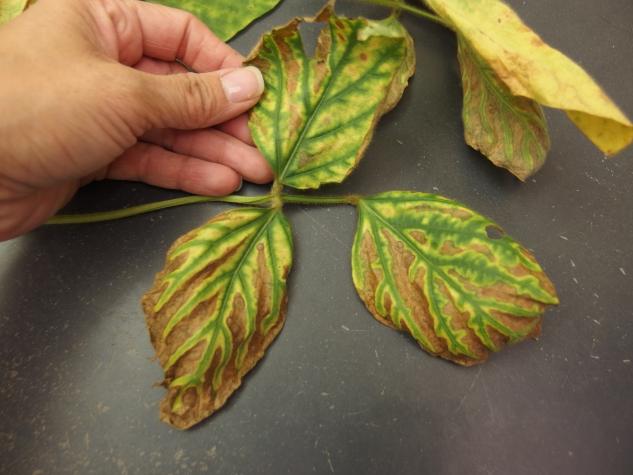Keep records for future use.
COLUMBIA, Mo. – University of Missouri Extension agronomists reported during their weekly teleconference that sudden death syndrome (SDS) is showing up in soybean fields across the state.
MU Extension plant pathologist Kaitlyn Bissonnette says she is not surprised that the yield-robbing disease has reared its ugly head.
Fields showing symptoms now have had root infection for months, she says. SDS begins in wet springs like this year’s, when the soilborne pathogen Fusarium virguliforme infects soybean roots. Rain during the reproductive growth stages allows the pathogen’s toxins to move from the roots to the leaves. SDS appears in both upland and river bottom fields.
Because SDS is soilborne, it is important to monitor fields with a history of the disease. Foliar symptoms include yellow blotches between leaf veins that turn brown in the center. As the disease progresses, the leaves curl upward and may fall from the plant. Stem canker and brown stem rot cause similar foliar symptoms, so it is important to scout and properly diagnose disease to form effective management strategies.
Damage ranges from trace losses up to 80%, depending on variety and when symptoms first appear. Yield losses of 5%-15% are most common.
While there is no rescue treatment once SDS appears, producers can take preventive measures.
Keep a record of fields where SDS occurs. Consider planting resistant varieties and using seed treatments during the next season, Bissonnette says.
Foliar symptoms of SDS are sometimes worsened in fields infested with soybean cyst nematode (SCN). If you have never tested a field for SCN or it has been several years since your last SCN test, consider soil sampling this fall after harvest, she says.
Management options include variety selection, improving drainage, avoiding continuous soybeans and managing SCN. Seed treatments labeled for SDS may provide additional early season protection.
For more information, the MU Extension publication “Soybean Diseases” (IPM1002) is available for free download at extension.missouri.edu/publications/ipm1002.
Photo available for this release:
Sudden death syndrome in soybean
Foliage symptoms of sudden death syndrome in soybean. MU Plant Diagnostic Clinic.
